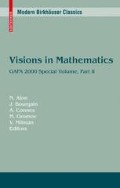Abstract
The discipline of information theory was founded by Claude Shannon in a truly remarkable paper [Sh] which laid down the foundations of the subject. We begin with a quote from this paper which is an excellent summary of the main concern of information theory:
The fundamental problem of communication is that of reproducing at one point either exactly or approximately a message selected at another point.
A large part of this paper is included in the paper “Quantum Shannon Theory,” which appeared in the IEEE Information Theory Society Newsletter 50:3 (September 2000), 3–5 and 28–33.
Access this chapter
Tax calculation will be finalised at checkout
Purchases are for personal use only
Preview
Unable to display preview. Download preview PDF.
References
G.G. Amosov, A.S. Holevo, R.F. Werner, On some additivity problems in quantum information theory, LANL e-print math-ph/0003002, available at http://xxx.lanl.gov.
H. Barntjm, J.A. Smolin, B.M. Terhal, Quantum capacity is properly defined without encodings, Phys. Rev. A 58 (1998), 3496–3501.
J.S. Bell, On the Einstein-Podolsky-Rosen paradox, Physics 1 (1964),195–200.
C.H. Bennett, H.J. Bernstein, S. Popescu, B. Schumacher, Concentrating partial entanglement by local operations, Phys. Rev. A 53 (1996), 2046–2052.
C.H. Bennett, G. Brassard, C. Crépeau, R. Jozsa, A. Peres, W.K. Wootters, Teleporting an unknown quantum state via dual classical and Einstein-Podolsky-Rosen channels, Phys. Rev. Lett. 70 (1993), 1895–1899.
C.H. Bennett, P.W. Shor, J.A. Smolin, A.V. Thapliyal, Entanglement-assisted classical capacity of noisy quantum channels, Phys. Rev. Lett. 83 (1999), 3081–3084.
C.H. Bennett, P.W. Shor, J.A. Smolin, A.V. Thapliyal, manuscript in preparation.
C.H. Bennett, S.J. Wiesner, Communication via one-and two-particle operators on Einstein-Podolsky-Rosen states, Phys. Rev. Lett. 69 (1992), 2881–2884.
E. Biham, M. Boyer, P.O. Boykin, T. Mor, V. Roychowd-hury, A proof of the security of quantum key distribution, in “Proceedings of the Thirty-Second Annual ACM Symposium on Theory of Computing,” ACM Press, New York, (2000), 715–724; longer version LANL e-print quant-ph/9912053, available at http://xxx.lanl.gov.
D. DiVincenzo, J.A. Smolin, P.W. Shor, Quantum-channel capacity of very noisy channels, Phys. Rev. A 57 (1998), 830–839.
C.A. Fuchs, A. Peres, personal communication.
J.P. Gordon, Noise at optical frequencies; information theory, in “Quantum Electronics and Coherent Light; Proceedings of the International School of Physics Enrico Fermi, Course XXXI (P.A. Miles, ed.), Academic Press New York (1964), 156–181.
D. Gottesman, An introduction to quantum error correction, LANL e-print quant-ph/0004072, available at http://xxx.lanl.gov.
D.M. Greenburger, M.A. Horne, A. Shimony, A. Zeilinger, Bell’s theorem without inequalities, Am. J. Phys. 58 (1990), 1131–1143.
P. Hausladen, R. Jozsa, B. Schumacher, M. Westmoreland, W.K. Wootters, Classical information capacity of a quantum channel, Phys. Rev. A 54 (1996), 1869–1876.
K. Hellwig, K. Krauss, Operations and measurements II, Communications in Mathematical Physics 16 (1970), 142–147.
A.S. Holevo, Information theoretical aspects of quantum measurements, Probl. Info. Transm. (USSR) 9:2 (1973), 31–42 (in Russian); [translation: A.S. Kholevo, Probl. Info. Transm. 9 (1973), 177–183].
A.S. Holevo, The capacity of the quantum channel with general signal states, IEEE Trans. Info. Theory 44 (1998), 269–273.
M. Horodecki, P. Horodecki, R. Horodecki, Unified approach to quantum capacities: Towards a quantum noisy coding theorem, LANL e-print quant-ph/0003040, available at http://xxx.lanl.gov.
R. Jozsa, B. Schumacher, A new proof of the quantum noiseless coding theorem, J. Modern Optics 41 (1994), 2343–2349.
L.B. Levitin, On the quantum measure of information, in “Proceedings of the Fourth All-Union Conference on Information and Coding Theory, Sec. II”, Tashkent, 1969.
L.B. Levitin, Optimal quantum measurements for pure and mixed states, in “Quantum Communications and Measurement, ” (V.P. Belavkin, O. Hirota, R.L. Hudson, eds.), Plenum Press, New York and London (1995), 439–448.
H.-K. Lo, H.F. Chau, Unconditional security of quantum key distribution over arbitrarily long distances, Science 283 (1999), 2050–2056.
D. Mayers, Unconditional security in quantum cryptography, J. ACM, to appear; also LANL e-print quant-ph/9802025, available at http://xxx.lanl.gov.
J.R. Pierce, The early days of information theory, IEEE Trans. Info. Theory 19 (1973), 3–8.
B. Schumacher, Quantum coding, Phys. Rev. A 51 (1995), 2738–2747.
B. Schumacher, M. Westmoreland, Sending classical information via a noisy quantum channel, Phys. Rev. A 56 (1997), 131–138.
C.E. Shannon, A mathematical theory of communication, The Bell System Tech. J. 27 (1948), 379–423, 623–656.
P.W. Shor, J.A. Preskill, Simple proof of security of the BB84 quantum key distribution protocol, Phys. Rev. Lett. 85 (2000), 441–444.
W.K. Wootters, W.H. Zurek, A single quantum cannot be cloned, Nature 299 (1982), 802–803.
Author information
Authors and Affiliations
Editor information
Editors and Affiliations
Rights and permissions
Copyright information
© 2000 Birkhäuser Verlag, Basel
About this chapter
Cite this chapter
Shor, P. (2000). Quantum Information Theory: Results and Open Problems. In: Alon, N., Bourgain, J., Connes, A., Gromov, M., Milman, V. (eds) Visions in Mathematics. Modern Birkhäuser Classics. Birkhäuser Basel. https://doi.org/10.1007/978-3-0346-0425-3_9
Download citation
DOI: https://doi.org/10.1007/978-3-0346-0425-3_9
Publisher Name: Birkhäuser Basel
Print ISBN: 978-3-0346-0424-6
Online ISBN: 978-3-0346-0425-3
eBook Packages: Mathematics and StatisticsMathematics and Statistics (R0)

